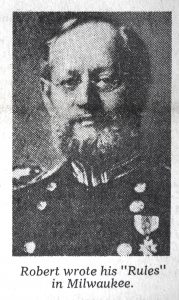Anyone that has held a meeting to official standards most likely has followed Robert’s Rules of Order. They even have a website! This has been in book form since 1873 when it was written by Maj. Henry Martyn Robert. Major Robert was a South Carolinian who came to Milwaukee after the Civil War when he was assigned to the Army Corps of Engineers to oversee harbor improvements. Leave it to the long, Milwaukee winters to inspire one to write, even if it isn’t poetry but an extensive rulebook.

Below is an article from the Milwaukee Journal of April 5, 1970 telling the story of Robert’s Rules:
Milwaukee’s Top Seller
The most famous book that ever came out of Milwaukee has just appeared in a new revision. The book is “Robert’s Rules of Order,” and the revision is described by its publisher— Scott, Foresman — as the first major one in 55 years.
It was not quite a century ago that Maj. Henry Martyn Robert of the title began to write out some thoughts on parliamentary procedure. After the Civil War, Robert had come to Milwaukee as an Army engineer concerned with the defense and the improvement of the harbors and light houses of Lake Michigan. He composed his little handbook, he subsequently related, in the winter of 1873-’74 when he “had a few weeks to spare” from his maritime duties.
The Lieutenant Was Embarrassed
The decision to write a simple and practical guide to parliamentary principles grew out of an embarrassment he had suffered during the war. Though he was a South Carolinian by birth, he fought on the Union side.
In 1863, half a dozen years out of West Point, young Lt. Robert was called upon to act as chairman of a meeting of citizens in New Bedford, Mass. The New Bedford whalers were much exercised by Confederate raids on their far ranging ships, and the townspeople gathered in a Baptist church to discuss the matter.
“I plunged in,” Robert wrote later, “trusting that the assembly would behave itself.” On the contrary, the sharp Yankees gave the callow gavel wielder a hard time. Mortified, he set out to learn as much as he could about parliamentary order and put it down briefly and clearly in a single book.
Like many an author before and since, he found publishers less enthusiastic about his project than he was. The big New York house of Appleton promptly rejected the manuscript. Finally he had 4,000 copies “ready printed” at his expense by the Milwaukee job shop of Burdick & Armitage. He talked the Chicago publishing house of C. S. Griggs into having them bound, also at his expense.
About 1,000 copies were given to legislators and others in and out of politics. They found them useful, recommended them to friends, and “Robert’s Rules of Order” was on its way. Its original title was “Pocket Manual of Rules of Order for Deliberative Assembles,” but the publisher printed the other name as a subtitle on the jacket, and that was the one that stuck. The author left Milwaukee in 1878.
2,600,000 Copies and No Paperbacks
Through the years, says the present publisher, the manual has sold well over 2,600,000 copies in seven earlier editions. The new edition has had a first printing of 100,000.
Though Robert died in 1923 (he was then a retired brigadier general), the Robert family has retained a connection with the book and its fortunes. The eighth, current edition was prepared by Mrs. Sarah Corbin Robert, the general’s daughter-in-law, and her son, Henry Martyn Robert III. They had the assistance of James W. Cleary, president of San Fernando State College in California, and William Evans, a Baltimore lawyer and parliamentarian. About three-quarters of the book has been rewritten, so that in its present form it is about twice as long as it was in its previous, 75th anniversary edition.
If a paperback edition had been sanctioned, the sale of the book by this time might be astronomical. But the Robert heirs have insisted that it have hard covers.
Said Henry Martyn Robert III the other day:
“If you use the book as you should, a paperback edition would be worn out in no time.”
More information can be found here.
Thanks for reading!